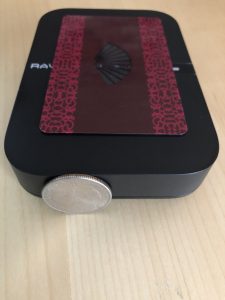 My most popular post on rsts11 has been my compact VMware server at home post. Thanks to Chris Wahl mentioning me on the VMware forums, and linking from his lab post, I see a dozen visits or more a day to that page.
My most popular post on rsts11 has been my compact VMware server at home post. Thanks to Chris Wahl mentioning me on the VMware forums, and linking from his lab post, I see a dozen visits or more a day to that page.
Imitation is the sincerest form of laziness^wflattery
I have to admit that I’ve been a follower in my use of intriguing lab environments. I got the vTARDIS idea from Simon Gallagher, and built a version of it at work at my last job on a Dell Core 2 Quad workstation under my desk. Then I saw Kendrick Coleman tweet about this new SH67H3 from Shuttle that supported 32GB of non-registered RAM… bought one and put 32GB and an i7-2600S processor into it, as mentioned in the “server at home” post mentioned above.

Now as you may know, the i7-2600 series processors are now a generation behind. Sandy Bridge gave way to Ivy Bridge (the i7-3×00 processors) which are currently easily found at retail. But… SH67H3 v1.0 motherboards don’t support Ivy Bridge. And that’s what was shipping when I bought mine in early 2012.
I found an unbelievable deal on a second SH67H3 open (missing) box at Fry’s in February 2013… let’s just say I spent more on a basic Pentium chip to test it with than I did on the chassis itself. But alas, the second one also had a v1.0 motherboard.
Let’s make the ivy (bridge) grow!
I found sources on the Internets that said a v2.0 board supporting Ivy Bridge was out. I further discovered that Shuttle would trade in your v1.0 board for a v2.0 board for $40. Instructions here at Cinlor Tech’s blog if you’re interested in doing this yourself. Note that you can request the case number through Shuttle’s web-email portal if you prefer this to calling. That’s what I did.
 I shipped off my two boards in a medium Priority Mail box to Shuttle on the 26th. On the 29th I got confirmation of the return shipment. They should be at my door on April 2nd. I’ll be reinstalling them, and at some point upgrading to the i7-3770s processors on both.
I shipped off my two boards in a medium Priority Mail box to Shuttle on the 26th. On the 29th I got confirmation of the return shipment. They should be at my door on April 2nd. I’ll be reinstalling them, and at some point upgrading to the i7-3770s processors on both.
Waitasec, 2600 “S”? 3770 “S”? What’s this all about, then?
Yes, that’s correct. I chose to go with a low power version of the i7-2600 processor a year and change ago. The i7-2600s has a lower base speed than the 2600 or 2600k (unlocked version), 2.8ghz vs 3.4ghz. All three support turbo boost to 3.8ghz though. And the i7-2600s is 65W where the others are 95W.
(Here’s a comparison chart of the three i7-2600 and three i7-3770 processor options via Intel, if you’re curious.)

Other noteworthy differences are on the 2600k, which costs $20 more, but does not support VT-d (directed I/O), vPro management features, or Trusted Execution. VT-d is the only feature of particular concern when you’re building your virtualization lab though. (I’ll admit the VT-d was an accidental discovery–I chose the 2600s more for power savings than anything else). If you’re building a desktop, the “K” model has HD3000 graphics vs HD2000 for the other two chips, by the way.
Now that I’m building a second box, I find that my usual local retail sources don’t have the i7-2600s in stock anymore. I could order one on eBay or maybe find it at Fry’s, but for about the same price I could get the Ivy Bridge version and be slightly future-proofed. Once again, the “S” is the way to go.
The 3770 series run at 3.1ghz (“S”), 3.4ghz (3770), and 3.5ghz (“K”) base speeds, all turbo capable to 3.9ghz. The “S” processor is 65W again, vs only 77W for the other two chips. They all have Intel’s HD4000 integrated graphics and the newer PCIe 3.0 support. They support 1600mhz RAM speeds, vs 1333 top for the previous generation. The “K” processor lacks VT-d, vPro, and Trusted Execution, but does have a nearly $40 premium over the other two chips.
All six of these chips have VT-x including extended page tables (EPT/SLAT), hyperthreading, and enhanced SpeedStep. And they’re all 4 core/8 thread/32gb RAM capable processors that make a great basis for a virtualization environment.
 So what’s next, Robert?
So what’s next, Robert?
Well, with two matching machines, I’ll be basically starting from scratch. Time to upgrade the N40L Microserver NAS box to 16GB (Thanks Chris for finding this too!) and probably splitting off a distinct physical storage network for that purpose.
But now, thanks to Marco Broeken’s recent lab rebuild, I’ve been introduced to Intel’s Next Unit of Computing (NUC), so tune in soon for my experience with my first NUC system. Sneak peek of the ESXi splash screen and the actual unit here… stay tuned!







 I shipped off my two boards in a medium Priority Mail box to Shuttle on the 26th. On the 29th I got confirmation of the return shipment. They should be at my door on April 2nd. I’ll be reinstalling them, and at some point upgrading to the i7-3770s processors on both.
I shipped off my two boards in a medium Priority Mail box to Shuttle on the 26th. On the 29th I got confirmation of the return shipment. They should be at my door on April 2nd. I’ll be reinstalling them, and at some point upgrading to the i7-3770s processors on both.
 So what’s next, Robert?
So what’s next, Robert?